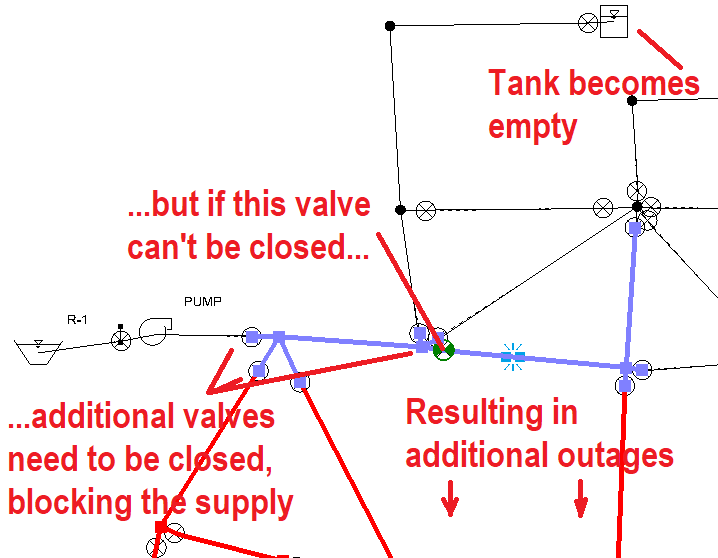| Product(s): |
WaterGEMS, WaterCAD |
| Version(s): |
10.02.XX.XX and greater |
| Area: |
Modeling |
Background
Starting with the CONNECT Edition Update 2 release of WaterGEMS and WaterCAD, a new Critical Valves option is available in the Criticality tool.
Valve Criticality enables you to determine which valves are most critical in water delivery - those that would result in the largest demand shortfall if they failed and could not be operated.
Note: this article contains information specifically about the Critical Valve option and does not include detailed information on using the Criticality tool. For more general information on Criticality, see: Running a Criticality Analysis
Note: if you intend to use the Critical Valve analysis and are using version 10.02.02.06, please update to a newer version (if available) or contact Technical Support (post on our forum) for the latest cumulative patch set, as there are some important fixes related to this feature, in that specific version. Newer versions will include the fixes.
How to Performance a Critical Valves Analysis
To perform a critical valves analysis, select the "Critical Valves" option when creating a new Criticality Study in the Criticality tool:

Ensure that the proper options are selected for which type of valves to consider. Compute the root critical valves study first, then compute the segmentation, followed by criticality, within the critical valves study. Analyze the results in the table and use the highlight buttons in the Segmentation and Criticality sections to visualize and color code in the model network.
How Does Valve Criticality Work?
When performing Valve Criticality, each row in the result table represents a valve that is stuck open. The results quantify the impact of that valve being stuck open in a case where a pipe somewhere in the two adjacent outage segments is broken and the segment has to be isolated. In order to perform that isolation, the valve in question (and others) would need to be closed, but because it cannot be closed (due to failure or some other reason such as being paved over) additional isolation valves need to be closed on the other side. This may result in additional customer outages and the row in the results table for the respective valve shows the total outage. In this manner, you can identify valves that are most critical based on demand shortfall.
The valve criticality feature also supports EPS simulations, so for example if a tank would eventually become empty and cause demands to be out of service, this is accounted for. Ensure that the "run hydraulic engine" box is checked in the Criticality section of the Valve Criticality run, and that the scenario in question is configured as Extended Period Simulation.
Example
The following is an example fictitious model (based on the below example model) in which a pump and tank are able to supply demands:

If a pipe broke on the right side, isolation valves would need to be closed, but as long as all of those valves are working properly, the pump and tank would still be able to supply demands in the rest of the network:

However, if the valve indicated in green below could not be closed for some reason (failed, broken, paved over, etc), additional valves on the left side would need to be closed in order to isolate the break, which would then block the pump and tank from supplying the demands in the rest of the model.

If the "Run hydraulic engine" box is NOT checked in the Criticality section in this example case, the demands near the top of the model would still be supplied and would not be part of the System Demand Shortfall.
"Run Hydraulic Engine" UNCHECKED:

However in reality, the tank would eventually drain out, become empty, and the demands near the tank would be out of service. To account for this, ensure that the "Run hydraulic engine" check box is checked, and that the scenario in question is configured as Extended Period Simulation with the appropriate duration set (according to how long the isolation valve would be closed.
"Run Hydraulic Engine" CHECKED:

Example Model
An example model is available with your WaterGEMS/WaterCAD installation. From the "Lessons" subfolder within the installation folder, open the file named CritStart. This model is configured with isolation valves (and is used in the above example) and can be configured with PDD by choosing the option in the calculation options.
NOTE : Patch has been developed for WaterGEMS / WaterCAD version 10.03.05.05, related to how Criticality handles initial status of check valves, FCVs, pumps , VSPs , turbines etc. which shall improvise the criticality results. Also fixed issue in how pipe check valves are handled for outage search. To get the latest patch please contact Technical Support. This patch will be included in later versions of 10.03.05.05.
See Also
Running a Criticality Analysis